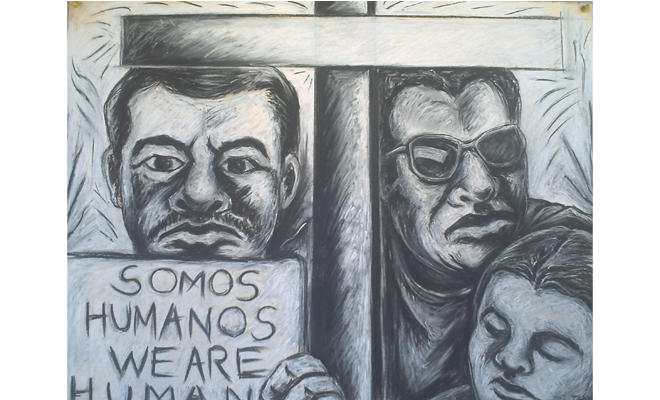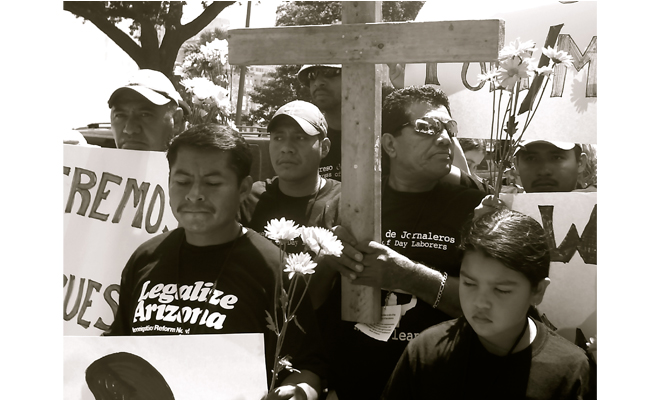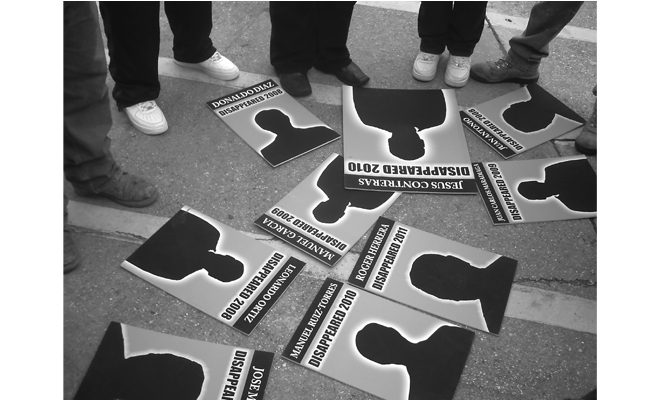The Buried Secret: Somos Humanos

José Torres-Tama, Somos Humanos/We are Human, 2013. Pastel on Arches paper. Courtesy the artist.
Editor's Note
Formerly on view in New Orleans, José Torres-Tama's “Photo Retablos and Drawings: Somos Humanos/We Are Human” travels to Birmingham, Alabama. On the occasion of the opening tonight, Denise Frazier reviews.
Armed with a skeleton mask, a black felt top hat, and a shekeré, José Torres-Tama is coming for you! With poetry as spicy as the guacamole he serves (immigrant haters better not reach for chips because you get none), his performances at theaters and universities across the country have struck a poignant, caustic, and, for some, “uncomfortable” chord. His latest exhibition, “Photo Retablos and Drawings: Somos Humanos/We Are Human,” focuses on the plight of Latino immigrants in post-Katrina New Orleans, advocating that their role in the city’s reconstruction narrative is and should be anything but invisible.
In July of 2010, Torres-Tama rushed to document a vigil/demonstration sponsored by the Congress of Day Laborers, a local organization serving the disproportionately immigrant population who seeks daily work standing on corners throughout the city. For Torres-Tama, one of the attractions of the demonstration, which mourned the “disappearances” of Latino immigrants from the local jail, was the opportunity to connect the performative with everyday struggle. Acknowledging the historical import of both street festivals and political protests in Latino culture, he states: “I loved documenting the demonstration because it’s live art!”
In his St. Roch home and studio, Torres-Tama moves deftly through the shotgun living room turned exhibition space. He points to the front wall filled with demonstration photographs in wooden frames constructed in the tradition of Mexican altar boxes or retablos. First shown at the Contemporary Arts Center last summer, then exhibited during Photo NOLA 2012 in his studio, the works now travel to Space One Eleven in Birmingham. Torres-Tama crafted them out of recovered wood and discarded drawers found on the street. The black and dark green speckled retablos appear almost regal in appearance housing black-and-white archival prints of Latino families.

José Torres-Tama, When an Immigrant Dies/Vigil for Jose Nelson Reyes-Zelaya, 2012. Archival print. Courtesy the artist.
In one photograph, the street is papered with haunting placards containing black outlines of torsos with the names of the disappeared men. In another retablo, there is a photo showing six demonstrators. Most are wearing black shirts with the phrase: “We are reconstruction workers.” A young girl in the far right-hand corner with down-turned eyes and furrowed eyebrows stands in front of a man in reflective shades carrying a big wooden cross. Many of the photographs like this one are reminiscent of a funeral, conveying a timeless and realistic account of the mortal jeopardy involved in the reconstruction of New Orleans.
Deepening this sense, each retablo includes a tiny battery-operated second-hand mechanism that ticks like a wall clock. According to Torres-Tama, the clock hand represents the heart of the immigrant as he informs New Orleanians of what he calls “the dirtiest little secret” of the reconstruction efforts. As if the content was not provoking enough, the ticking sounds beg our ears to never stop hearing the hearts that rebuilt New Orleans. The incessant ticking of the clocks recalls Edgar Allan Poe’s “Tell-Tale Heart.” In Poe’s story, the murderous protagonist is driven mad by the beating heart of the dead man buried underneath the planks of his home. And, as in the story, the buried secrets of our city will not wait for revelation. The truth is that many of the Latino immigrants that rebuilt post-Katrina New Orleans suffered (and continue to suffer) a myriad of injustices including slave labor, wage theft, and racially motivated violence. Torres-Tama’s exhibition tells us that until this truth is fully revealed “the noise will steadily increase,” and we must not turn a blind eye to this lucha/struggle.

José Torres-Tama, Names of the Disappeared/Nombres de Los Desaparecidos, 2012. Archival print. Courtesy the artist.
Editor's Note
“Photo Retablos and Drawings: Somos Humanos/We Are Human” on view through May 17 at Space One Eleven (2409 2nd Ave N) in Birmingham, Alabama.



